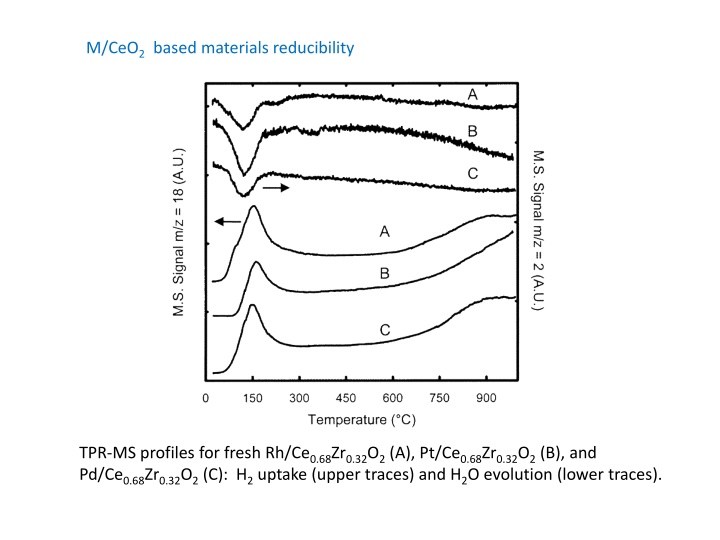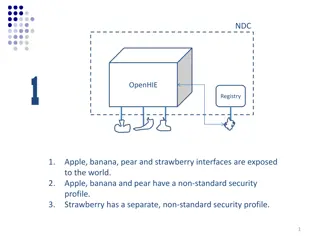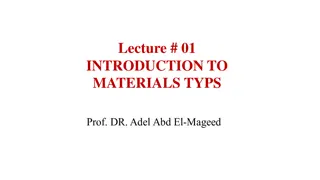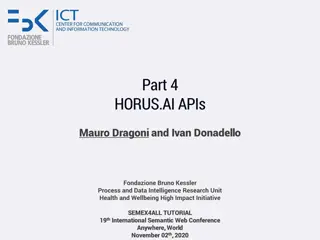Materials Reducibility Profiles: Rh, Pt, and Pd on Ce0.68Zr0.32O2
This content explores the reducibility profiles of Rh, Pt, and Pd on Ce0.68Zr0.32O2 materials through TPR-MS analysis. It also discusses the synthesis of nanoparticles through wet chemistry methods such as high-temperature decomposition, attrition, pyrolysis, etc., along with liquid-phase synthesis and colloidal chemical methods.
Download Presentation

Please find below an Image/Link to download the presentation.
The content on the website is provided AS IS for your information and personal use only. It may not be sold, licensed, or shared on other websites without obtaining consent from the author.If you encounter any issues during the download, it is possible that the publisher has removed the file from their server.
You are allowed to download the files provided on this website for personal or commercial use, subject to the condition that they are used lawfully. All files are the property of their respective owners.
The content on the website is provided AS IS for your information and personal use only. It may not be sold, licensed, or shared on other websites without obtaining consent from the author.
E N D
Presentation Transcript
M/CeO2 based materials reducibility TPR-MS profiles for fresh Rh/Ce0.68Zr0.32O2 (A), Pt/Ce0.68Zr0.32O2 (B), and Pd/Ce0.68Zr0.32O2(C): H2 uptake (upper traces) and H2O evolution (lower traces).
Pd nanoparticle and chemisorption at 25C (A) and the same sample oxidized at 427 C and rereduced at 150 C (B)
Nanoparticle Synthesis Wet Chemistry High-temperature decomposition of organic precursors Attrition Pyrolysis RF Plasma Pulsed Laser Method Biosynthesis ..
Liquid phase synthesis Precipitating nanoparticles from a solution of chemical compounds can be classified into five major categories: (1) colloidal methods; (2) sol gel processing; (3) microemulsions method; (4) hydrothermal synthesis; (5) polyol method. Solution precipitation relies on the precipitation of nanometer-sized particles within a continuous fluid solvent. An inorganic metal salt, such as chloride, nitride and so on, is dissolved in water. Metal cations exist in the form of metal hydrate species, for example, Al(H2O)63+or Fe(H2O)63+. These hydrates are added with basic solutions, such as NaOH or NH4OH. The hydrolyzed species condense and then washed, filtered, dried and calcined in order to obtain the final product.
Colloidal Chemical Methods Colloidal methods are simple, easy, cheap and well established wet chemistry precipitation processes in which solutions of the different ions are mixed under controlled temperature and pressure to form insoluble precipitates. For metal nanoparticles the basic principles of colloidal preparation were known since antiquity. E.g. gold colloids used for high quality red and purple stained glass from medieval times to date. However, proper scientific investigations of colloidal preparation methods started only in 1857 when Faraday has published results of his experiments with gold. He prepared gold colloids by reduction of HAuCl4with phosphorus. Aggregation is prevented by electrostatic repulsion or the introduction of a stabilizing reagent that coats the particle surfaces. Particle sizes range from 1-200 nm and are controlled by the initial concentrations of the reactants and the action of the stabilizing reagent.
Precipitation/coprecipitation Mg2+(aq) + 4H2O Mg(OH)2 +2H3O+(aq) Kps = [Mg2+ ][OH-]2 = 1,8 x 10-11 Fine tuning of pH to avoid consecutive precipitation Metal precursors chlorides, nitrates, acetate,.. Precipitating agents, NaOH, NH4OH, Na2CO3 . Precipitate must - Be cheap: - have low solubility; - be easy to decompose; - lead to safe decomposition. 6
Precipitation/coprecipitation Precipitation occurs in three steps i) supersaturated solution; ii) nucleation; iii) grain growth The solubility curve is a function of temperature and concentration (pH); the supersaturated solution is unstable. The supersaturated conditions can be obtained by solvent evaporation, by dropping the temperature or by increasing the pH of the solution. Saturated solution: A solution that contains the maximum amount of a solute that can be dissolved at equilibrium at a given temperature. Unsaturated solution: A solution that contains less than the maximum amount of a solute that can be dissolved at a given temperature. Supersaturated solution: A solution that contains more than the maximum amount of a solute that can be dissolved under equilibrium conditions at a given temperature. When a supersaturated solution is disturbed in any way, the excess solute will separate and the equilibrium solubility is restored.
Precipitation /co-precipitation Nucleation = the appearance of solid nuclei in the solution. It can be homogeneous (agglomeration of ions from the pure solution) or heterogeneous (crystallization agents). The dimension of the final nanoparticles depends on the ration between the rates of nucleation and growth, and on the possible aging strategies. nucleation growth primary time Induced /secondary The rate of nucleation depends on the level of supersaturation (easier preparation with low solubility compounds) Highly soluble compounds leads to a rapid dissolution of the smallest nanoparticles followed by deposition on the largest nanoparticles with the obtainment of large precipitate.
Precipitation/coprecipitation Weimarn s law D x C0 = constant C0 = initial concentration D = particle dimention Cs = solubility L1 > L1 > L1 = solubility When C0 is high = the precipitation is controlled by nuclei formation When C0 is small = the precipitation is controlled by the rate of nuclei growth
Precipitation/coprecipitation Effect of Temperature and Concentration on the precipitation of CaCO3 (a) Calcite (T<25 C) (b)Aragonite (70-80 C) (c) Vaterite (T> 40 C high concentration) Ca(HCO3)2 (aq) CaCO3 + H2O + CO2
Precipitation/coprecipitation Ca(OH)2 CaCl2 (aq)+2 NaOH (aq) Ca(OH)2(s) + 2 NaCl (aq) 17
Precipitation/coprecipitation Addition of NaOH to a CaCl2/H2O/methanol solution Adsorption of OCH3 on the 001 facets with the suppression /inhibition of their growth 18
Precipitation by increasing pH : increasing the pH (one element to precipitate) at constant pH (the most used case) at constant pH in a continuous flow 19























